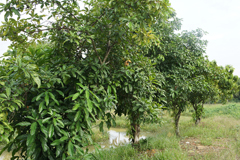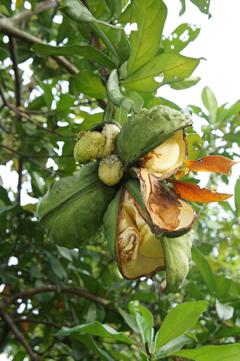 |
|
Michael Hermann wikimedia.org |
 |
| Michael Hermann wikimedia.org |
Translate this page:
Summary
Native to Sierra Leone, Liberia, Ivory Coast, Ghana, and Nigeria, Cola nitida, or Cola Nut/ Ghanja Kola, is a tropical tree of about 8-12 in height that grows in lowland rainforest. It is buttressed to 1m high and its trunk can be branchless for a few meters. The bark is cracked and grey in colour but small branches are smooth. The leaves are simple, leathery, and dark green. The flowers form into short, irregular clusters forming a cup. They are white with red marks inside. The fruits are green, shiny, made up of 5 cells which curve back, and contain about 10 seeds per fruit. The seed has a stimulant effect, especially on the heart. Powdered seed can be taken internally in tonics and as a treatment for diarrhoea. C. nitida is used interchangeably with C. acuminata as they have similar medicinal uses. It is chewed to stimulate the nervous system and to counteract overstrain and depression. It has astringent properties and is used as a non-addictive stimulant against dysentery, diarrhoea, vomiting in high fever, headaches, and migraine. The seed is aromatic and rich in caffeine. It is chewed or ground into a powder and made into drinks. Extract from dried kernels is used as flavouring in carbonated drinks, ice cream, candies, and baked goods. Furthermore, the plant is used as shade trees in cocoa plantations. The wood is susceptible to borers but can be used in furniture, house an boat building, plates, etc. It also is a good fuel source.
Physical Characteristics

 Cola_nitida is an evergreen Tree growing to 20 m (65ft) by 20 m (65ft) at a slow rate.
Cola_nitida is an evergreen Tree growing to 20 m (65ft) by 20 m (65ft) at a slow rate.
See above for USDA hardiness. It is hardy to UK zone 10.
Suitable for: light (sandy), medium (loamy) and heavy (clay) soils and prefers well-drained soil. Suitable pH: mildly acid, neutral and basic (mildly alkaline) soils and can grow in very acid and very alkaline soils.
It can grow in semi-shade (light woodland) or no shade. It prefers dry or moist soil and can tolerate drought.
UK Hardiness Map
US Hardiness Map
Synonyms
Cola acuminata latifolia K.Schum. Cola vera K.Schum. Sterculia nitida Vent.
Plant Habitats
Edible Uses
The aromatic seed is especially rich in caffeine, with some seeds having up to 3.5% caffeine, and acts as a stimulant[ 238 , 301 ]. It can be chewed or ground into a powder and made into a drink in order to give energy, increase alertness, retard hunger and fatigue, aid digestion and increase stamina[ 301 ]. When chewed, it also has the effect of modifying the taste sensation so that any food or drink consumed immediately afterwards seems sweet[ 301 ]. An extract, prepared from the dried kernels, is used to flavour carbonated drinks, ice cream, candy, baked goods etc[ 301 ].
References More on Edible Uses
Medicinal Uses
Plants For A Future can not take any responsibility for any adverse effects from the use of plants. Always seek advice from a professional before using a plant medicinally.
The seeds are an astringent, bitter-sweet, anti-depressant herb that has a stimulant effect, especially on the heart[ 238 ]. The powdered seeds are taken internally in tonics, in the treatment of exhaustion, low energy and poor appetite[ 238 ]. They are also used in treating diarrhoea[ 238 ]. The following information has been copied from the entry for Cola acuminata since the seeds are used interchangeably[ 254 ]. Cola nuts contain up to 2.5% caffeine, plus theobromine, tannins, phlobaphene and an anthocyanin[ 254 ]. They stimulate the nervous system when chewed and are also considered to be a digestive tonic, diuretic, astringent and antidepressant[ 254 , 303 , 307 ]. They counteract overstrain and depression thus improving the physical and mental state. The principle action is that of caffeine. Other active principles include theobromine and kolatine[ 303 ]. Because of its astringent properties, cola is used as a non-addictive stimulant in the treatment of diarrhoea and dysentery[ 254 , 303 ], and also to prevent vomiting in cases of high fever[ 303 ]. It has also been used in the treatment of headaches and migraine[ 254 ]. It has been used in combination with coca leaf (Erythroxylum coca) to produce a stimulant drug that has been used as 'Forced March' tablets by explorers and military expeditions[ 303 ]. The crushed nuts are boiled together with the leaves of Morinda lucida and the liquid taken internally to cure piles[ 303 ]. The nuts ground to a fine paste together with the leaves of Scoparia dulce, are dissolved in a little water and a few drops are administered orally to babies for headache[ 303 ]. The seeds are harvested when fully ripe and dried in the sun[ 254 ]. An infusion of the bark mixed with ginger and a little pepper is taken internally to cure stomach ulcers[ 303 ].
References More on Medicinal Uses
The Bookshop: Edible Plant Books
Our Latest books on Perennial Plants For Food Forests and Permaculture Gardens in paperback or digital formats.

Edible Tropical Plants
Food Forest Plants for Hotter Conditions: 250+ Plants For Tropical Food Forests & Permaculture Gardens.
More

Edible Temperate Plants
Plants for Your Food Forest: 500 Plants for Temperate Food Forests & Permaculture Gardens.
More

More Books
PFAF have eight books available in paperback and digital formats. Browse the shop for more information.
Shop Now
Other Uses
Agroforestry Uses: Plants are often used as shade trees in cocoa (Theobroma cacao) plantations[ 238 ]. Other Uses The sapwood is pinkish-white and the heartwood dull yellow[ 303 ]. The wood is susceptible to borers[ 324 ]. It is suitable for furniture, house and boat building, coach-work, plates, domestic utensils, gun stocks, joinery and carvings[ 303 , 324 ]. The wood is a good source of fuel[ 303 ].
Special Uses
References More on Other Uses
Cultivation details
A plant of the hot, humid, lowland tropics, where it is found at elevations up to 800 metres. It can be cultivated in drier areas as long as ground water is available[ 324 ]. It grows best in areas where annual daytime temperatures are within the range 21 - 30°c, but can tolerate 10 - 35°c[ 418 ]. It prefers a mean annual rainfall in the range 1,400 - 2,500mm, but tolerates 1,200 - 3,500mm[ 418 ]. It is capable of withstanding 3 or more months of dry season[ 324 ]. Prefers a rich, well-drained soil and a position in full sun[ 238 ]. Young trees require some shade[ 324 ]. Prefers a pH in the range 5 - 6, tolerating 4.3 - 7[ 418 ]. Initial growth is slow, with trees reaching only 3 metres in 4 years[ 324 ]. Trees start producing at around the age of 12 - 15 years and can produce 10 - 16 kilos of seed annually for more than 80 years[ 238 ]. Yields of 300 nuts per tree are considered good[ 324 ]. In some regions the tree may flower almost all the time, so harvesting is continuous throughout the year[ 418 ].
References Carbon Farming Information and Carbon Sequestration Information
Temperature Converter
Type a value in the Celsius field to convert the value to Fahrenheit:
Fahrenheit:
The PFAF Bookshop
Plants For A Future have a number of books available in paperback and digital form. Book titles include Edible Plants, Edible Perennials, Edible Trees,Edible Shrubs, Woodland Gardening, and Temperate Food Forest Plants. Our new book is Food Forest Plants For Hotter Conditions (Tropical and Sub-Tropical).
Shop Now
Plant Propagation
The seeds are thought to require a period of dormancy for effective germination and growth. Pre-soaking for 24 hours can improve the level of germination[ 325 ]. Sow the seed individually in containers[ 200 ]. Germination is slow, taking 2 - 3 months[ 324 ]. Germination within 10 - 18 days has been achieved when the seed was sown at a temperature of 30°c[ 325 ]. Higher germination levels have been achieved when the cotyledons were parted before sowing[ 325 ]. The improved germination could be a result of the removal of this mechanical constraint[ 325 ]. Seedlings can be planted out after about 12 months[ 325 ]. The seeds are sensitive to drying and low temperatures[ 325 ]. They do not tolerate drying to less than c. 30% moisture content. They can be maintained for one year or more without loss in viability, with the seeds wrapped in banana leaves at room temperature.[ 325 ]. Cuttings of mature wood[ 200 ].
Other Names
If available other names are mentioned here
Cola nitida, or Cola Nut/ Ghanja Kola, Other Names: Ajauru, Bakuru, Buur, Cola, Coleira, Colo-fuque, Curo-djo-o, Curo, Evbe, Ghanja Kola, Goro, Mancuur, N'kola, Obi-gbanja, Uncurame.
Native Range
AFRICA: Côte D‘Ivoire, Ghana, Guinea, Liberia, Sierra Leone, Togo
Weed Potential
Right plant wrong place. We are currently updating this section.
Please note that a plant may be invasive in one area but may not in your area so it's worth checking.
None Known
Conservation Status
IUCN Red List of Threatened Plants Status : This taxon has not yet been assessed

Growth: S = slow M = medium F = fast. Soil: L = light (sandy) M = medium H = heavy (clay). pH: A = acid N = neutral B = basic (alkaline). Shade: F = full shade S = semi-shade N = no shade. Moisture: D = dry M = Moist We = wet Wa = water.
Now available:
Food Forest Plants for Mediterranean Conditions
350+ Perennial Plants For Mediterranean and Drier Food Forests and Permaculture Gardens.
[Paperback and eBook]
This is the third in Plants For A Future's series of plant guides for food forests tailored to
specific climate zones. Following volumes on temperate and tropical ecosystems, this book focuses
on species suited to Mediterranean conditions—regions with hot, dry summers and cool, wet winters,
often facing the added challenge of climate change.
Read More
Expert comment
Author
(Vent.) Schott & Endl.
Botanical References
Links / References
For a list of references used on this page please go here
A special thanks to Ken Fern for some of the information used on this page.
Readers comment
| Add a comment |
|
If you have important information about this plant that may help other users please add a comment or link below. Only comments or links that are felt to be directly relevant to a plant will be included. If you think a comment/link or information contained on this page is inaccurate or misleading we would welcome your feedback at [email protected]. If you have questions about a plant please use the Forum on this website as we do not have the resources to answer questions ourselves.
* Please note: the comments by website users are not necessarily those held by PFAF and may give misleading or inaccurate information.
To leave a comment please Register or login here All comments need to be approved so will not appear immediately.
|
|